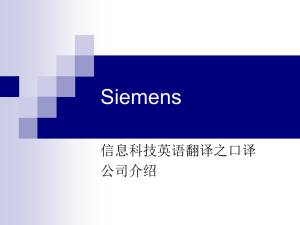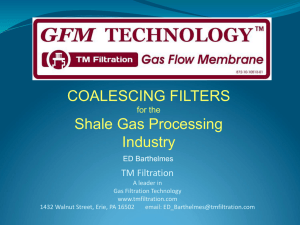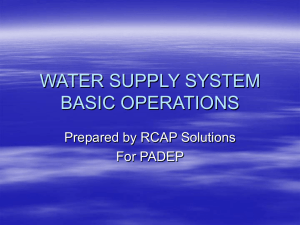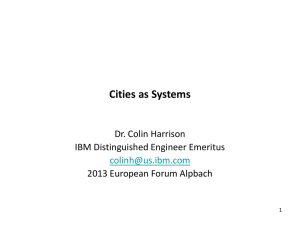Cross-Flow or Tangential Flow
advertisement
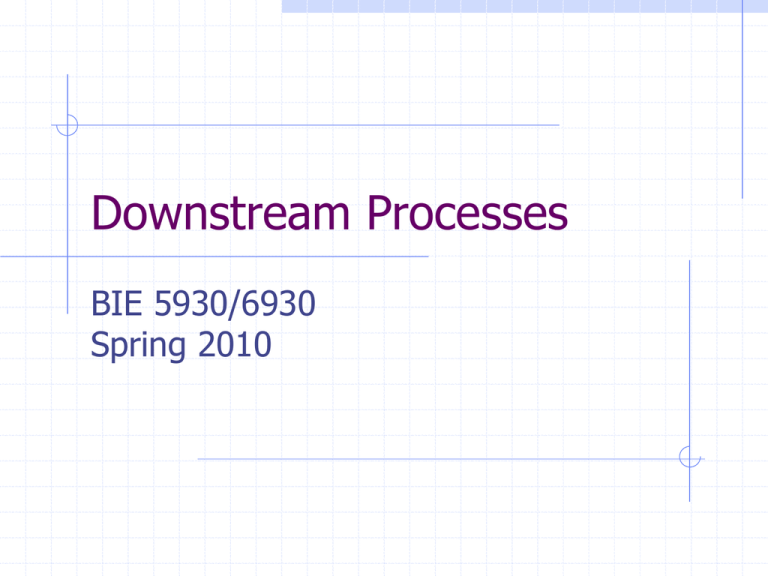
Downstream Processes BIE 5930/6930 Spring 2010 Filtration Filtration is the use of a medium to separate solids from liquid. The solids can be from the size of cells or cellular tissue to individual ions. Depending on the filtration medium chosen as the filter material selective cut-off of particle sizes are achieved in the filtration process. Selection of the proper filtration method is often referred to as an art as well as science. There basic equations the help to predict how efficient a filtration process will be are understood, but many of the subtleties of each individual system make experimentation an important part of any filtration system design Filtration systems require at least a filtration membrane and can include additional layers of a filter cake that aids in increasing performance of the membrane Filtration in protein separation is usually utilized to concentrate the material prior to/or after a more selective affinity column. Filtration can provide selectivity based on size, but not on charges, etc. Types of filtration Filtration is usually broken down into two primary techniques: deadend cross-flow filtration DeadEnd Filtration (Through flow) Deadend filtration is when the feed material is forced through the membrane. The flow is only in the direction perpendicular to the membrane. All the suspended solids in the feed end up on the membrane in a filter cake Cross-Flow Filtration (Tangential flow) In cross-flow filtration the feed material is allowed to flow parallel to the membrane, while the pressure gradient is across the membrane. The primary advantage of cross-flow filtration is that it allows the solids to be kept in suspension and minimizes the build up of a filter cake to plug or foul the membrane Filtration Classification Classification of filtration falls into several categorizes depending on the size of the particles being excluded by the membrane Microfiltration generally refers to the filtration of suspension particle such as cells and cellular fragments Ultafiltration is the filtration of macromolecules Reverse Osmosis is the filtration of molecules such as salts and sugars Deadend filtration Depth filtration Cake filtration Depth filtration Depth filtration is traditionally filtration with sand or a clarify cartridge. Solids are trapped in the void space in the medium. As solids accumulate the filtrate plugs and the flow rate approaches zero. The filter bed must be replaced or regenerated. Depth filtration is best used in a low solids material that requires clarifying because of the rapid degradation of performance with high solids loads Cake filtration Cake filtration generally refers to the use a selectively porous material that traps a layer of solids above it. The layer is called the filter cake. The material used can be cloth or paper membranes. Often a layer of filter aid (diatomaceous earth) is placed on the membrane to improve the performance of the filtration process and to allow the filtration system to operate longer between regeneration by providing a removable layer in the system Flow theory for filtration Flow through a cake is described by: Flow through a cake is described by: dV = Adq P W m a r A V = volume of filtrate A = filter area q = time P = pressure across filter medium a= average specific cake resistance W= weight of the cake r = resistance of the filter medium m=viscosity In other words: Flow Rate Force = Unit area Viscosity Cake Resistance Filter MediumResistance To optimize the flow rate •Increase the area of the filter •Increase the driving pressure •Reduce the viscosity of the fluid (usually by heating or addition of water) •Reduce the Cake resistance •Reduce the resistance of filter medium Filter Cake Thickness The filter cake thickness will increase with time of operation. In a batch operation the a decision point must be reached as to how thick the cake can get before it begins to effect the efficiency of the operation. While a thin cake may have less resistance, if the time to shut down the filtration system and remove the build-up is greater than the lose of efficiency from the reduce flow it may be beneficial to operate with a thicker cake than optimal in each cycle Filter Aid Filter aid such as diatomaceous earth can be added to the cake directly or mixed in to the product slurry. The filter aid will increase the porosity of the filter cake and therefore reduce the cake resistance. In general filter aid is added at approximately 1-2 % of the overall slurry weight. An other general rule of thumb is to add twice the volume of filter aid as solids in the slurry Cake filtration equipment Filter Press Nutsche Filters Rotary Vacuum Drum Filter Filter Press The filter press is still one of the most commonly used filters in many operation The basic design is a series of filter screens that alternately allow the filtrate and permeate to flow through the screens and filter cake Nutsche Filters The Nutsche is one of the simplest designs of batch filters. The tank is feed with a slurry and the bottom of the tank is comprised of the filter membrane Rotary Vacuum Drum Filter The rotary drum filter is the most common of the continuous cake filters. It allows the cake to be continuously be removed Theory of Filtration In filtration, solid particles are separated from solid-liquid mixtures by forcing the fluid through a filter medium or filter cloth that retains the particles. The Filtration rate can be improved either by using a vacuum or pressure. Filter aides such as Diatomaceous Earth which are highly porous also improve the filtration rate. Filtration theory is used to estimate the rate of filtration. Theory of Filtration The rate of filtration is usually measured as the rate at which liquid filtrate is collected. Filtration rate depends upon: 1. Area of the filter cloth 2. Viscosity of the fluid 3. The pressure difference across the filter 4. The resistance to filtration offered by the cloth and deposited filter cake. Darcy’s Law Describes the flow of liquid through a porous bed of solids: 1 dV P = A dt m f R At any instant during filtration, the rate of filtration is given by the equation: A = Vf = P = mf = Mc = a = Rm = filter area volume of the filtrate pressure drop across the filter filtrate viscosity total mass of solids in the cake in the filtrate volume Vf average specific cake resistance (LM-1) filter medium resistance (L-1). This includes the resistance offered by the filter cloth. 1 dVf = A dt P Mc m f a Rm A a a is the measure of resistance of the filter cake to flow. Its value depends upon the shape and size of the particles and size of the interstitial spaces between them. Resistance of the filter medium is negligible in comparison to that of the cake resistance (a). a, the specific cake resistance can be related to P empirically: a = a ' P s s = 0 if the cake incompressible s = 1 if the cake is highly compressible a’ is a constant and depends upon site and morphology of the particles in the cake Determining filtration time Integration of the rate equation will allow the calculation of the time required to obtain a given amount of filtrate (filtrate volume). The mass of solids in the cake will depend upon the volume of filtrate collected (for a given concentration of solids in the liquid-solid mixture) Theory of Filtration Let Mc = rcVf , the mass of solids deposited per unit of filtrate volume. Concentration of solids in the solid-liquid system = c, where c is the mass of solids per volume filtrate and is related to the concentration of solids in the material to be filtered. 1 dVf = A dt m f a m f a r cV f A P rcV f Rm A Rm dVf = AP dt t Vf o o Adt = At = m f arc AP m f arc V f Vf V f dVf AP 2 o 2 m f Rm P m f Rm P Vf dVf Theory of Filtration At = Or and t V f m f arC V f AP 2 2 m f Rm P Vf m f arC m f Rm Vf = 2 AP 2 A P This can be rewritten simply as: t = K1V f K 2 Vf What type of equation is this? Where K1 = mar C 2 A P 2 K2 = m f Rm AP Theory of Filtration If we maintain P as constant during filtration, K1 and K2 remain as constants during constant pressure filtration. t = K1V f K 2 is an equation for a The equation Vf t straight line, when is plotted against Vf. Vf The slope K1 depends upon P and properties of the cake. The intercept K2 also depends upon the pressure drop, but is independent of cake properties. a is calculated from the slope and (Rm) is determined from the intercept. The above equation is the basic filtration equation. Batch Filtration Increasing filtration rate Consideration of the equation for filtration rate will indicate the various strategies that can be adopted for increasing the filtration rate. 1. increase the filtration area 2. increase the filtration pressure drop (vacuum filtration) P increases a, which causes filtration rate to reduce. 3. reduce the cake mass (Mc) 4. reduce the liquid viscosity (by dilution) 5. reduce the specific cake resistance (a). Factors affecting specific cake resistance 1. increasing porosity 2. reducing specific surface area of the particles (by increasing the average size of the particles and by reducing the particle size distribution) Increasing filtration rate Experiments should first be conducted to evaluate the properties of the cake such as compressibility, specific cake resistance, filtrate clarity, ease of washing, dryness of the final cake, ease of cake removal, the effects of filter aids. Fungal mycelia are filtered relatively early because mycelial filter cake has a large porosity. Yeast and bacteria are much more difficult to handle because of their small size. Review mfa Cf t = 2 A P ' Vf m f Rm V f 2 A P 2 Example: Filtration of Mycelial Broth: A 30 ml sample of broth from penicillin fermentation is filtered in the laboratory on a 3 cm2 filter at a pressure drop of 5 psi. The filtration time is 4.5 min. Previous studies have shown that filter cake of Penicillium chrysogenium is significantly compressible with s = 0.5. If 500 liters of broth from a pilot-scale fermenter must be filtered in one hour, what size filter is required if the pressure drop is 10 psi. Cross-Flow Filtration Cross-Flow or Tangential Flow In cross-flow filtration (CFF) the membrane does the primary work compared to the combination of cake and membrane in deadend cake filtration. The cross-flow allows the membrane to be swept free of solids allowing for a lower resistance to fluid flow through the membrane Cross-Flow or Tangential Flow The term cross-flow refers to the fact that the flow direction of the retentate is perpendicular to the flow direction of permeate. The pressure gradient for the flow is still across the membrane, while the retentate is allowed to flow through the system Cross-flow also allows the concentration of the retentate without the contamination with filter aids. Therefore CCF can be used to collect either the permeate or the retentate Advantages of Cross-flow Filtration Deadend Filtration Process Goal Crossflow Filtration Ability to handle wide variation in particle size Excellent Generally poor Ability to handle wide variations in solids concentration Continuous concentration with recycle Excellent Poor or unacceptable Excellent Poor or unacceptable Waste minimization Superior Can minimize waste if handling low solids feed where cartridge disposal is infrequent High product purity or yield Excellent Performance is generally acceptable except in situations involving high solids or adsorptive fouling Membrane types and cleaning Type of foulant Example Cleaning solution Filter Material Compatibility Inorganic Precipitated Ca, Mg, Fe Moderate to strong acidic Some polymeric (PVDF or PTFE)and most inorganic filters Organic Citrate, tartrate, gluconate Acidic/alkaline solutions Most polymeric or inorganic filters Proteins Enzymes, yeast Mild to moderately alkaline Most polymeric or inorganic filters Proteins Pectins Strongly alkaline, preferably with chlorine Some polymeric (PVDF or PTFE)and most inorganic filters Biological debris E-coli, bacteria, cell walls Moderately Alkaline Most polymeric or inorganic filters Fats/Oils Stearic acid, oleic acid Strongly alkaline with oxidizing agents or chloride Some polymeric (PVDF or PTFE)and most inorganic filters Polysacch aride Starch, cellulose Strongly alkaline/acidic or oxidizing solutions Some polymeric (PVDF or PTFE)and most inorganic filters Membrane Configurations Spiral wound Hollow fiber Cross-flow Filtration Systems Concentration Factors Many products start out in very low concentrations in the original broth This requires very high concentration or removal of most of the water from the system Concentration Example If one liter of broth has one gram of the desired material How much permeate must be removed to get to a concentration to 2 g/l? Ultrafiltration and Microfiltration Theory Microfiltration 0.1 to 10 μm filter sizes Used to separate cells Ultrafiltration MW range 2000 to 500,000 (2 to 500 kilo Daltons (kD)) Used to concentrate or sieve proteins based on size Anisotropic membranes A thin membrane with small pores supported by a thicker membrane with larger pores Low MW solutes pass through the filter and high MW solutes are retained Pressure driven process Can result in concentration polarization and gel formation at membrane surface Ultrafiltration and Microfiltration At steady state: Rate of convective transport of solute towards membrane = rate of diffusive transport of solute in opposite direction dc , where, dx De is theeffectivediffusivity of solut ein theliquid film (cm2 /s) Jc = D e J is the volumetric filtrationflux of theliquid (cm3 /cm2 s) c is theconcentration of solut e (mol/cm3 liquid) For a boundry layer thicnkess of , thiscan be solved: cw cw JD J = ln or = exp cb cb D D is defined as themass transfercoeffientk cw is defined as thepolarization modulus. cb Polarization Modulus cw cb • The polarization modulus indicates the extent of the concentration polarization. • Concentration polarization can become severe at values greater than 10 • Solubility values can be exceeded at higher concentration and gels or solids can form on the membrane surface Gel Effect Ultrafiltration and Microfiltration Filtration flux (J) is a function of Transmembrane pressure drop (ΔPM) Gel layer concentration (CG) Mass transfer coefficient (K) Bulk solute concentration (CB) If no solute is present, then Flux is a function of ΔPM only. If solute is present and RG is constant, flux still increases linearly with ΔPM If gel polarization occurs, RG is not constant and flux will no longer be a function only of ΔPM } From Gel polarization eq. Mass Transfer Coefficient For laminar flow systems: D k = 0.816 w L 2 1/ 3 Where gamma is fluid shear rate at the membrane surface. L is the length of the flow channel. w – Fluid Shear Rate in laminar flow For rectangular slit of height 2h and bulk stream velocity, ub: 3u b w = h For a circular tube of diameter D: 8u b w = D Turbulent flow kD h Sh = = f Re, Sc , L / Dh D Dhub r Re = = Reynoldsnumber m m Sc = = Schmidt number rD cross sectionalarea Dh = equivalentdiameter= 4 wettedperimeter Turbulent flow Sh = 0.082Re 0.69 0.33 Sc Example Solids effects Operations
